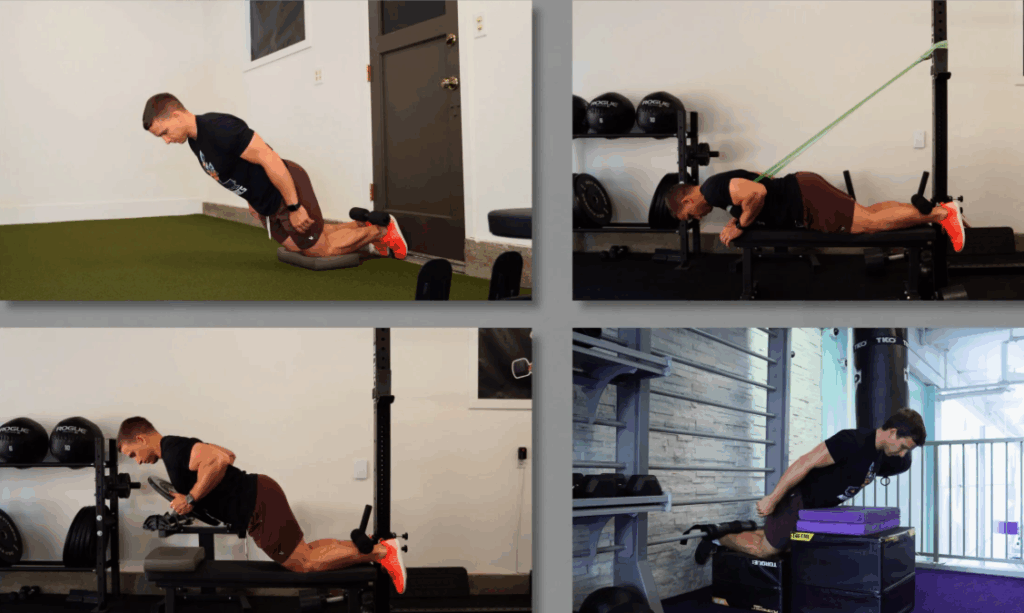To perfect your Nordic hamstring curl, kneel on a padded surface with feet secured and torso upright. Hold your shoulders straight, and tighten your core. Lower yourself forward slowly over 3-5 seconds, keeping your hips extended throughout. Use your hands to assist your return to start as needed. Focus on controlled movement and proper alignment to prevent injury.
Master this technique and you’ll greatly reduce your hamstring strain risk while building impressive posterior strength.
Understanding the Nordic Hamstring Curl
Powerhouses of the posterior chain, Nordic hamstring curls stand as one of the most effective exercises for targeting the hamstring muscles. The move mostly involves eccentric loading of the hamstrings.
When you perform a Nordic hamstring curl, you’re engaging your semitendinosus, semimembranosus, and biceps femoris. This exercise doesn’t just build strength; it improves the hamstrings’ ability to decelerate your body during running and jumping movements.
For athletes in sports requiring sprinting or quick direction changes, regular Nordic hamstring curl training can reduce hamstring strain risk by up to 65%, making it an invaluable addition to your training routine.

Proper Setup for the Exercise
The Nordic hamstring curl requires a solid base before you begin. Start with a secure anchor point for your feet. It can be a partner holding your ankles, a padded barbell across your heels, or other such equipment designed for this exercise.
Position yourself on a cushioned surface to protect your knees, kneeling with your torso upright. Your knees should be hip-width apart with ankles firmly secured. Keep your hips fully extended, not bent forward.
Start by engaging your core and setting your shoulders back before moving. This form ensures maximum control throughout the exercise, especially during the hard lowering phase.

Step-by-Step Execution
Once you’ve established a proper setup, mastering the execution of the Nordic hamstring curl requires careful attention to each phase of the movement. Begin by kneeling tall with your torso upright and core engaged.
Start the descent by hinging forward from your knees while maintaining a straight line from your shoulders to your knees. This eccentric training phase is where you’ll build the most strength, so lower yourself as slowly as possible. Aim for a 3-5 second descent. Keep your hips extended throughout the movement to guarantee proper technique.
When you’ve lowered as far as you can control, use your hands to push off the ground and assist your return to the starting position. As you get stronger, you’ll gradually reduce this assistance until you can perform the concentric phase using just your hamstrings.

Common Mistakes and How to Avoid Them
Despite its effectiveness, some people perform the Nordic hamstring curl incorrectly, which can reduce its benefits and potentially lead to injury. It is most common to break at the hips instead of the knees, because it transfers the load to your lower back from your hamstrings. Keep the shoulders to your knees straight throughout the movement to prevent this from happening.
Another error is descending too quickly, which prevents proper muscle activation and eccentric loading. Control your descent to engage the hamstrings fully. Watch for knee hyperextension at the top position, which can stress your joint unnecessarily.
Many athletes also forget to brace their core, resulting in a sagging midsection. Keep your abs tight and hips neutral to guarantee the exercise targets your hamstrings effectively.
Progressions and Variations for All Levels
Athletes can adapt the Nordic hamstring curl to suit their fitness levels, from beginners to elite performers. If you’re new to this bodyweight exercise, start with a partner-assisted version where someone holds your ankles and supports your torso during the descent.
As you build strength, try using resistance bands looped around your chest and anchored in front of you to reduce the difficulty. For intermediate progression, perform the exercise with your hands ready to catch yourself, but minimize their use.
Advanced athletes can add resistance by holding weight plates against their chest or using a weighted vest. Increase the challenge by performing the exercise on an incline or incorporating pause reps at various points during the descent.
Tips for Maximizing Results
Three key strategies will help you maximize the benefits of Nordic hamstring curls in your training program. Focus on quality first rather than quantity. Do 2-3 sets of 4-8 repetitions 1-2 times weekly as part of your strength training. This frequency permits proper recovery and growth.
Second, make sure you properly warm up with dynamic hamstring movements like leg swings and light Romanian deadlifts before attempting Nordics. It primes the muscle tissue and reduces injury risk during the intense eccentric loading.
Third, pair Nordic curls with complementary exercises like hip thrusts, deadlift variations, and glute bridges for thorough posterior chain development. This balanced approach creates synergistic effects that enhance overall lower-body strength and resilience.
Frequently Asked Questions
How Long Until I See Hamstring Growth From Nordic Curls?
You’ll typically notice hamstring growth after 4-6 weeks of consistent Nordic curls. For faster results, perform them 2-3 times weekly with proper form and pair them with complementary leg exercises.
Can I Perform Nordic Curls During Hamstring Rehabilitation?
You shouldn’t perform full Nordic curls during early rehabilitation. Consult your physical therapist first, as they’ll likely recommend modified versions that match your recovery stage and prevent reinjury to your healing hamstrings.
Do Nordic Curls Benefit Running Economy and Sprint Performance?
Yes, Nordic curls greatly improve your running economy and sprint performance by strengthening your hamstrings, enhancing posterior chain power, and developing eccentric control that directly translates to faster acceleration and reduced injury risk.
How Do Nordic Curls Compare to Leg Curl Machines?
Nordic curls offer greater functional strength and hamstring activation than leg curl machines. You’ll engage more stabilizing muscles and build better eccentric strength, though machines allow for easier progression with adjustable resistance.
Should I Feel Pain in My Knees During Nordic Curls?
No, you shouldn’t feel knee pain during Nordic curls. If you do, check your technique, guarantee proper padding under your knees, and consider modifications. Discomfort in your hamstrings is normal, but knee pain isn’t.








